The explorer AP Kazantsev discovered mysterious clay figurines in the Tohoku Region, Honshu Island, Japan. They were made by the people called Jomon in about 7,000 BC. As often happens with ancient art that represents strange shapes or that suggests a certain humanoid aspect, fans or scholars of the UFO phenomenon have not hesitated to associate these figurines with aliens, that is, they would be the representation of beings from other planets with whom the Jomon had contact at some point.

The reality is that these are figures that represent female deities, mostly simulating pregnancies, which has led archaeologists to conclude that they are representations of fertility goddesses, “mother goddesses” for the Jomon. The curious shape of the eyes (larger than normal), a kind of glasses in them, plus the compact bodies have led to seeing alien representations in these pieces.

Other fundamental features of the Dogu figures (do = earth, gū = doll) are the drawings on their bodies, which has led to the theory that tattoos or scarifications were part of the Jomon culture, which was characterized by having handled the clay with great skill to later turn it into ceramic. For other conspiracy theorists, the drawings are actually part of the design of a spacesuit with which these beings arrived on Earth.

One of the authors who uphold this idea as an absolute truth is Vaughn Greene, who wrote Astronauts of Ancient Japan, stating that the buttons that appear on the chests of the Dogu figurines are placed in the same position as a conventional spacesuit worn by NASA astronauts. However, none of this belongs to reality, nor has it been shown that the figurines represent beings from a foreign planet.

Apart from being a representation of fertility, it is believed that the Dogu figurines were capable of being recipients of diseases: a person would pray that she or a relative of theirs would get rid of a physical and perhaps emotional ill and pass to the figure. If this is true, the objects in question would be a kind of shamanic remedy that used magic to give its owner well-being. Figures have been found that was missing a part of the body and it is thought that this is because the person amputated that part of the body where he had an ailment that he wanted to eradicate from himself (something like a healing voodoo doll).
However, there is also a theory that the Dogu were nothing more than toys, religious images or simple objects of adornment, according to the theories of Shirai Mitsutarō, a founding member of the Tokyo Anthropological Society. Some were also found in tombs, which would reinforce the idea about their use as representations of fertility deities and the idea of rebirth when accompanying a dead person on their journey through the Hereafter.

Rafael Abad, Professor of the Degree in East Asian Studies at the University of Seville and specialist in History and Archeology of the Japanese archipelago, mentions in his extraordinary article entitled Dogū, the anthropomorphic representation in Japan Jōmon:
Apart from working in clay, the Jomon were expert hunters and farmers and lived in small houses made of wood and straw, and they were also one of the first societies established in what is now Japan, of which there are samples of their art. The Dogu Figurines are unlike anything seen before or after in Japanese archaeology. No other previous samples have been found that have influenced the Jomon artists in other corners of Japan, hence their character of fascination and mystery that has haunted them since their discovery.
The entire history of art is full of mysteries and hidden meanings that artists took care to put them deliberately in some of their works or that the passage of time has wrongly assigned them. These statuettes that we have just seen could be one of those enigmas with a logical explanation but that has taken an image of wide mystery, turning its characters into the most enigmatic women in the history of art.




